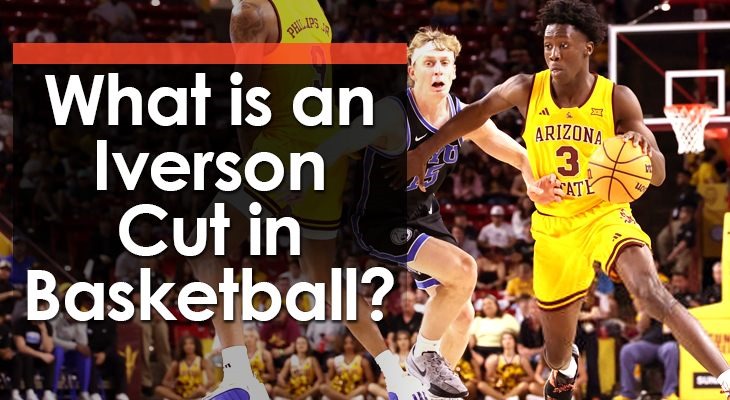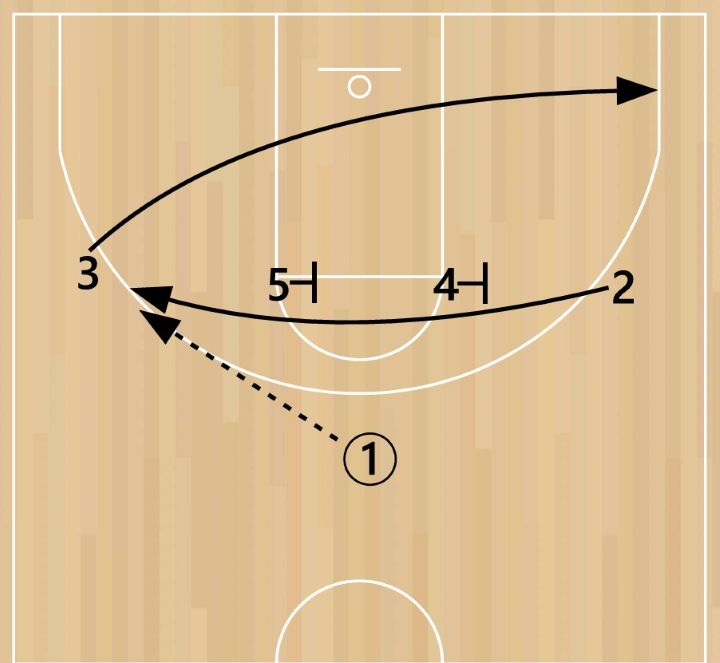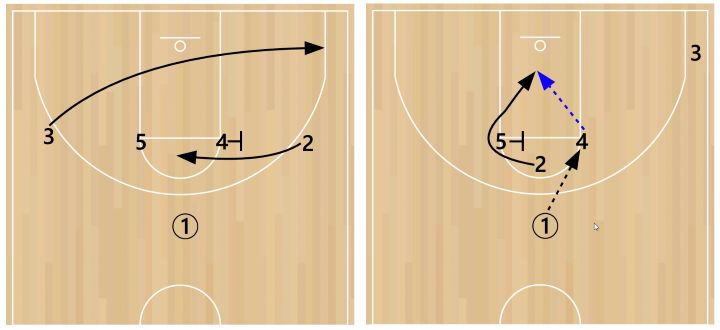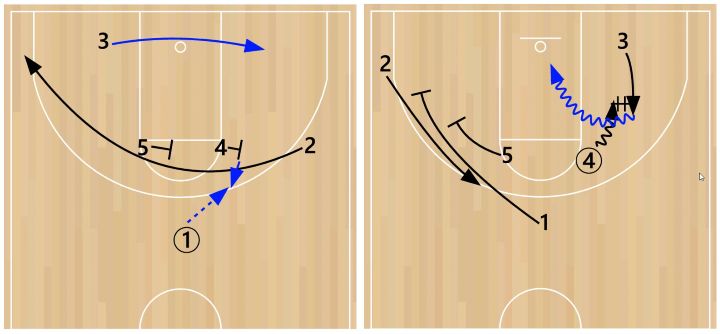
From an early age, basketball players are taught that a V-cut is an effective way to get open to receive a pass on the offensive end of the floor.
Eventually, players may also add an L-cut into their repertoire.
However, a cut that players also tend to learn later in their careers, which helps them get open and can lead to various offensive advantages, is the Iverson cut.
This blog post will take a look at just what an Iverson cut is, why it’s effective, and some examples of plays that utilize the Iverson cut.
What is an Iverson Cut?
An Iverson cut is an off-ball cutting action where an offensive player cuts over the top of two staggered screens, usually set near the elbows, to receive the ball on the wing.
The goal of an Iverson cut is to free up a player for a shot, drive, or backdoor cut and layup.
Here’s what it looks like:


3 clears out to the weak corner while 2 is the player executing the Iverson cut off of two screens near the elbows to help him get open on the opposite side of the floor.
While this screening does not HAVE to happen on an Iverson cut, it makes the cut more effective and more likely to be open.
How did the Iverson Cut get its Name?
The Iverson cut is named after former NBA Hall of Famer Allen Iverson, who frequently used this cut during his career to get open and create scoring opportunities.
Why is the Iverson Cut Effective?
The Iverson cut is an effective play on the basketball court for several reasons.
1. Versatile scoring options
The Iverson cut creates several potential advantages that can be tailored to the individual executing the action.
If you have a good driver cutting across the court to the other wing, there is a whole side of the floor cleared out for him, as well as a teammate exiting to the opposite corner, which may pull away any help defender from the lane.
On the other hand, if you have a shooter completing the Iverson cut action, then running his defender off two screens near the elbows will likely result in an open look from the wing.
2. Disrupts defensive structure
The action of an Iverson cut creates some unusual situations for the defense.
With two different cutters going over/under the two posts at the elbows, defenders must maintain their defensive integrity and get to their correct positions following cross-court cuts.
Only the most disciplined defenders will get to the correct spots, as chasing too far will create driving gaps up top, and stopping short will lead to open outside shots.
3. Flows seamlessly into other actions
Lastly, the Iverson cut is an effective offensive action because it immediately flows into other offensive actions with ease.
If nothing develops on the catch, then it can easily be followed with a pick-and-roll or an away screen and curl to the block for a big.
And if the defense plays the Iverson cut perfectly, another great option is to enter the ball into one of the elbows for a backdoor cut.
This action opens up many scoring opportunities, regardless of how the defense guards it.
Keys for a Good Iverson Cut
1. Square up to the basket quickly
An Iverson cut is a great way to get a player open.
However, it’s only effective if the player executing it squares up to the basket on the catch.
So, whichever player completes the Iverson cut, they must pivot immediately once they have the ball to use the advantage.
Players will need to practice this as they won’t be accustomed to catching the ball while moving directly toward the sideline.
However, if they can learn to reverse pivot on the catch and square up, these offensive players will find themselves with numerous scoring opportunities, regardless of their strengths.
2. Posts set solid, legal screens
Yes, having your posts screen is not a requirement of the Iverson cut. However, it definitely makes it a lot more effective if you do.
Having a cutter run off successive post screens, along with running across the court, almost guarantees that your perimeter player will be open on the wing after completing the Iverson cut.
But the posts must stay set on these screens or they risk being called for an illegal screen. Also, the wing must understand how to cut off them to run their defender into the screens.
Any contact on the screens will create an advantage on the catch and multiple scoring chances from the wing.
3. Flow into a secondary offensive action
The Iverson cut will likely get one of your players the ball on the wing.
And there’s a good chance he’ll immediately find himself with some sort of drive or shot as a scoring opportunity.
However, there will also be times when the defense does a good job of preventing an easy scoring chance after the catch, which means you need to have some sort of secondary action that the Iverson cut flows into, should it be needed.
Whether that’s a ball screen, a cross screen, a back screen, or any other type of the many basketball screens, all of them can be incorporated with an Iverson cut.
Examples of Iverson Cut Plays
The following video shows a variety of plays utilizing the Iverson cut that were effective at the college level. Take a look:
Here are the diagrams of my 3 favorite plays out of this playlist:
1. Iverson Curl Lob


This is a great set to run against a defense that is going to try to deny your best scorer all over the court, even on an Iverson cut.
Send your best player (3) on the Iverson cut to draw the defense that way, but instead of entering it to him on the wing, throw a pass to the opposite post (5).
Then, 3 can immediately curl after the 2nd screen and cut to the basket for a lob at the rim from 5 to make an overly aggressive defense pay.
2. Iverson Rip


An Iverson cut that actually gets the ball to your best post player on the block.
The Iverson cut initiates with 2 cutting off the two post screens to the opposite wing to receive an entry pass. Instead of cutting to the opposite corner, 3 cuts slowly to just above the block.
On the pass to 2, 3 sets a diagonal screen for 4 to dive to the block. After setting that screen, 5 and 1 set up a stagger screen for 2 to come to the top of the key.
3. Iverson Decoy DHO


Once again, the player completing the Iverson cut (2) is more of a decoy on this play, so keep that in mind when putting this play in.
The wing who cuts under the two post screens along the baseline (3) does so slowly to be positioned near the opposite block as the ball gets entered to the post on his side (4).
As a stagger is set on the weak side of the floor to keep the defense busy, 4 quickly turns toward the sideline to complete a DHO inside the 3-point line, which should turn into a downhill drive from 3 to the rim.
Conclusion
The Iverson cut is an often underutilized basketball cut that almost guarantees you will get a player open on the wing.
Because of both its path and the fact that it involves a player coming off two separate screens along the way, it is very difficult for the defense to deny a player crossing the court.
Allen Iverson used this move to help him score tons of baskets at the NBA level, so chances are it will work for you as well, no matter where you may be coaching.
Just make sure your players square up quickly on the catch, have two posts setting solid, legal screens, and you have a backup action to flow into if it doesn’t give you an immediate look.
Whether you use one of the plays highlighted above or come up with one of your own, find a way to incorporate the Iverson cut into your regular offensive attack.